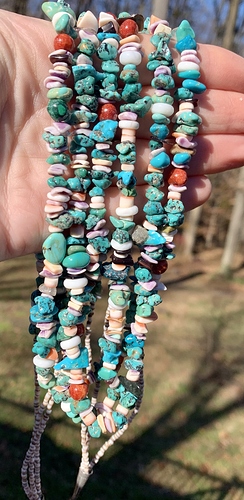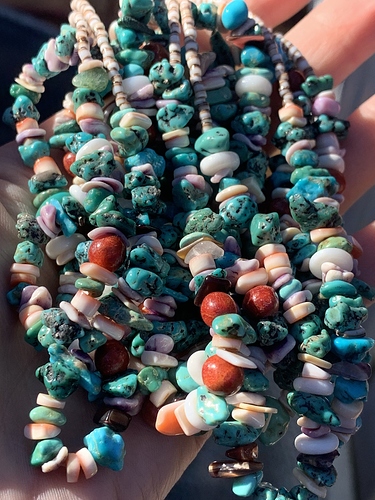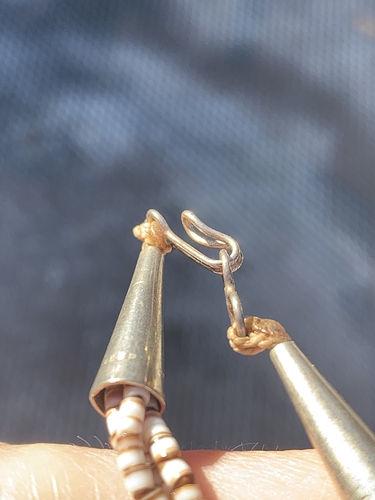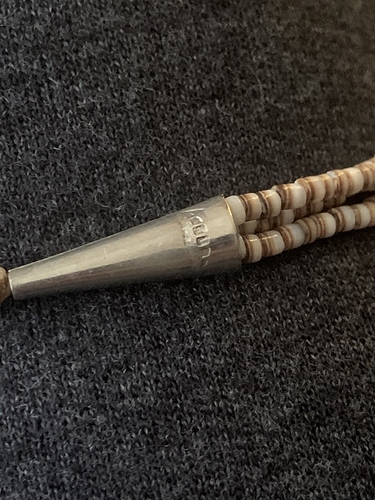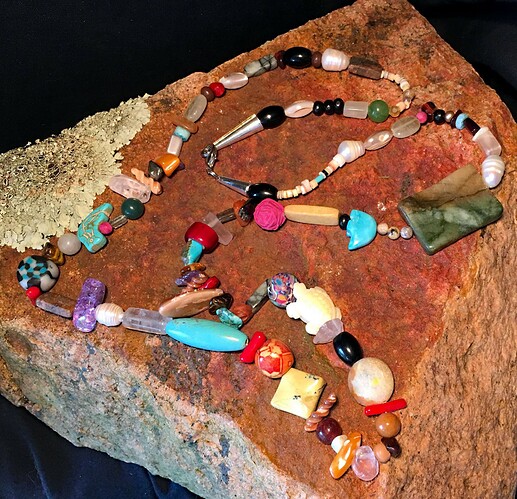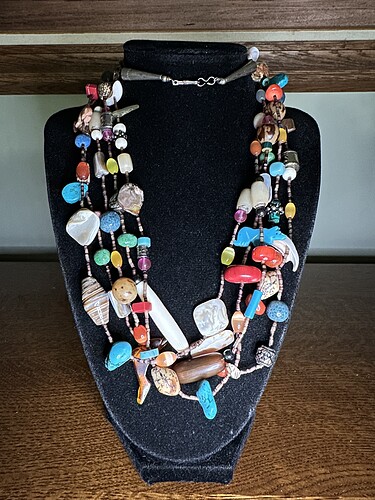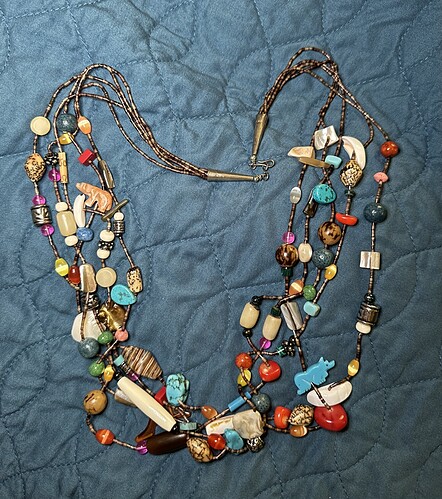Does anyone know what these are called?
I can’t find much information when I Google “stone necklace“ 
I don’t know what this is -if it’s authentic or an import? It’s heavy, 3 strands. The only marking on the cone ends are some lines. Thanks turquoise people!! 
Hmm, I’ve never seen anything quite like this and I’m not exactly sure how I would describe it. Maybe something like “eclectic three-strand nugget, shell, and bead necklace on heishe.” I don’t believe it’s Native American made–to me it looks a little too mish-mashy to be Native American and I’m seeing some materials that I’ve never seen in Native American jewelry: quartz-like stones and whatever those red balls are. The findings I believe are commercial and the stamped lines on them are probably a design or brand mark that came on them, not an artist’s hallmark.
I would also say that things like this aren’t necessarily either/or as in either authentic (I’m guessing you mean authentic Native American) or an import. It could have been made in the US by someone who wasn’t trying to pass it off as Native American, in which case it would fall between those two extremes (although I do suspect some of the materials are imported). Those are my thoughts, but I’m interested to here other people’s opinions.
I agree - this looks like a reproduction of a really old trade bead necklace i saw recently that was NA. It looks like it’s strung and finished like a NA piece would be, including what looks like some legit turquoise, but it incorporates some “craft” beads, heishe and stone chips that are commercially available. Without a maker’s mark or hang tag, it might be impossible to attribute to any one person or culture.
It’s got a great, fun crafty look to it. As a layering piece with other NA or other ethnic pieces, i think it works. I would call this “southwest inspired.”
I agree with the other two. The mystery red beads are an imported red compressed sponge coral. As an american handmade piece it is still of value and has nice form and seems well made as an interpretation of traditional hand strung beaded artwork. Cool find for both a decorative bead and materials find.
~Koliopee
A real work of art! Whatever the origin, someone who absolutely knew what they were doing with materials, color, and composition strung and crafted that sumptuous necklace with love and lots of skill. Wear it proudly. Fantastic piece! Absolutely gorgeous!!!
The closest term for it in NA work is “treasure necklace,” which I think is really just a term for Santo Domingo or SD-inspired multistone bead necklaces made for the marketplace, as opposed to being for Native use.
There really is a tradition of Native worn and Native made heishi necklaces that “grow” over time with the addition by the maker of various colored beads, usually to mark ceremonial or personal occasions. However, this very colorful, deliberately random-bead mishmash style, with a crowded appearance on the string, is a Santo Domingo specialty developed for the marketplace. Not that I’m assuring this is Native work, just explaining the type.
Example:
Thank You! I appreciate everyone’s very detailed response EXTREMELY helpful.
i am in agreement with the many above comments
the ‘red roundy things’ appear to be a sponge-type coral from the Philippines
nicely crafted design work
lovely piece !
Edit: wrote something about a type of bead that i’m not 100% sure about anymore.
I’ve also heard this style called a treasure necklace, and have seen them stated to be Native American. Years ago I attended several auctions that sold a lot of this style; but a questionable reputation for attribution. If I had to guess a NA origin I’d say Kewa, but I always thought they were likely produced in a cooperative. I have a lot of Kewa heishi and bead pieces, and haven’t seen anything with such a variety of beads and other materials. And, to my taste it’s somewhat messy.
I made some Treasure Necklaces a few years ago. They were well received.
I used a combo of newer and older beads. Included a description with what a Treasure Necklace was, history and some of the beads used.
The oldest beads were from the 1800’s and belonged to some of my ancestors.
Here is what I was told about this type of necklace by a Navajo Elder and what I included with the necklaces
I was first introduced to the Treasure Necklace shortly after moving to the Navajo Nation over 30 years ago. Later, I was blessed by being told (through an interpreter), the history and significance of these magnificent pieces of art.
Long ago, trading was an important part of survival. Many ancient cultures utilized beads and shells as a form of money. It was also an early form of marketing, per say. If a person gained the reputation of high craftsmanship, others would travel for hundreds of miles, or more, for the chance to obtain some of their work. The gift of a bead, of any material, was highly appreciated, as it showed that the giver truly respected and valued the recipient. Some of these beads had been in a family for generations. When a bead was given to another, it was said to carry the experiences of past owners. Their knowledge strengths, and life events. These accounts were sometimes shared with the recipients, who passed this information along with the bead.
Beads received in trade or as gifts were often placed on a single strand as received. This not only kept the beads safe, but when the strand became long enough, made for a very attractive jewelry piece. Shorter strands were often used as adornments for ceremonial clothing. This Treasure Necklace contains over 40 different types of beads from a variety of materials. Some are from the 1800’s.
@fernwood Thank you for sharing your knowledge of Treasure Necklaces. I love that it involves what is good in this world, family, friendship, history and art.
You are a treasure to this forum!
Thank you.
In my research, I also learned that Tommy Singer made some beautiful Treasure Necklaces,
@fernwood Would you consider this a treasure necklace? I purchased it online several years ago and have never worn it. There are 5 strands.
Thanks again for your informative posts.
Thanks for the relevant information @fernwood. Interesting discussion.
Looks like the Kewa origin is debunked, but as in @chicfarmer’s post they are now produced commercially by Kewa artists.
It was quite a while ago when I saw lots of them sold through in person auctions in California; somehow I’m remembering they were said to be Navajo (attribution was in question at this auction).
It it understandable that significant beads were “treasured”. Most of the necklaces are I’ve seen for sale are likely an attempt to copy these personal, valued, necklaces, and were made using commercially available beads. It’s questionable whether or not to call them “treasure” necklaces, since those made for commercial sale surely don’t contain treasured beads. But, with the history it’s probably the best description. The question, as always, is if an individual necklace in NA made.
My sisters and I call our trade bead necklaces our “ancestral beads” since most of the trade beads came from our grandmother. ![]() So ours are treasure necklaces but in a very different context.
So ours are treasure necklaces but in a very different context.
